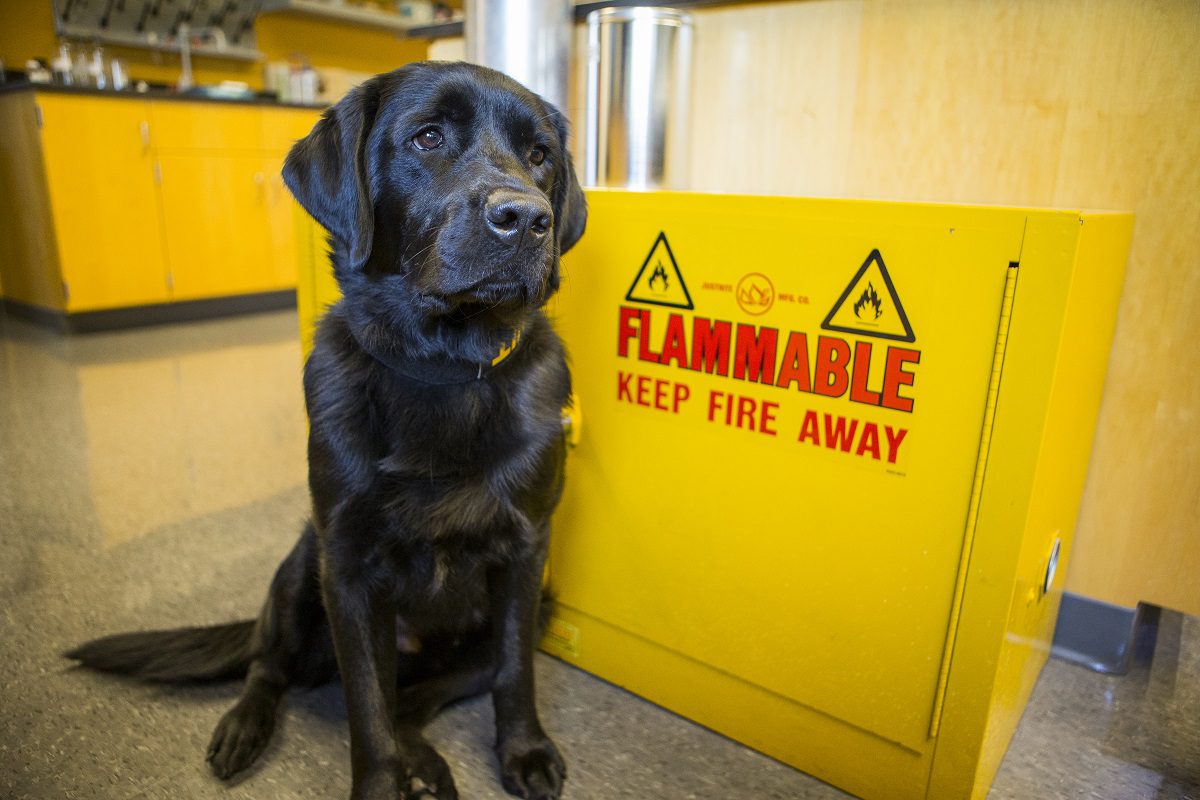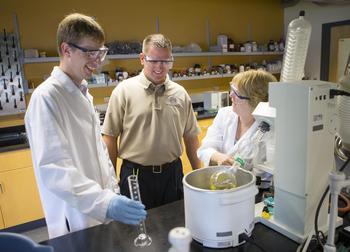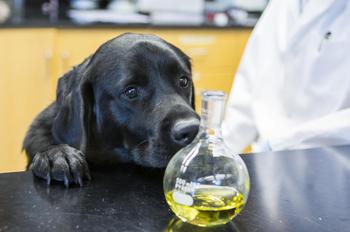Training dogs to sniff out arson

As a member of the Chemistry Department faculty for 30 years Laura Wright, Ph.D., has fielded her share of strange phone calls. But a call from Jason Nurmi of the nearby Parker Fire Department took her by surprise.
Nurmi, a fire marshal, wanted her help in training Jag, an arson dog.

Rivers (left) prepares samples for use in training Jag. Nurmi (center) and Wright (right) look on.
He needed gasoline samples that were evaporated to 50 percent of their original volume, which covers most of the accelerants Jag will encounter in an intentionally set fire.
Wright says specialized equipment and expertise are required to produce the training aid.
Nurmi was in the middle of 200 hours of training with Jag in a program led by Maine Specialty Dogs (Alfred, Maine) and sponsored by State Farm Insurance Company when he made the call to Professor Wright. Eager to assist in the cause, Wright agreed to help and tapped research student Nathan Rivers ’16 to distill the gasoline.
Using a rotary evaporator, Rivers prepared the samples and dispensed them into vials for Nurmi. “Without the samples, I can’t train Jag properly,” says Nurmi, who will use droplets of the accelerant at dozens of training venues to keep Jag sharp.

Jag checks out gasoline sample.
Jag is cute and cuddly with his silky, jet black fur and big brown eyes, but he’s an arsonist’s worst nightmare. State Farm, the only insurance company in the United States with an arson dog program, reports that the average prosecution rate in suspicious fires is 12 percent when an arson dog is not part of an investigation. When an accelerant detection canine is present in the investigation, there’s up to a 50 percent prosecution rate.
And here’s why. In a fire, the evidence burns up, but within a matter of minutes on the scene, trained dogs can zero in on the presence of ignitable liquid, a task that can take humans days to do.
An accelerant detection canine’s specialized nose has a sense of smell orders of a magnitude more acute than humans. Compared to our paltry 5 million olfactory receptors, dogs have up to 300 million. In fact, some say dogs can pick up scents on a scale of parts per trillion. Put another way, dogs can identify the presence of a teaspoon of sugar dissolved into a million gallons of water, or the amount in two Olympic-size pools.
With trainer in tow, Jag recently visited campus to demonstrate his work. Nurmi planted scant amounts of the training aid concocted by Rivers at selected spots along a hallway outside the lab in Townes Science Center. With Jag on leash, Nurmi quickly makes rounds up and down the hall calling out, Seek, seek, seek … It’s Jag’s body movements that reveal the location of the gas. He stops, lies down, places his nose on the target, then looks up at Nurmi. Naturally, Jag is rewarded with treats for his sleuthing.
“It’s really cool to see how my actions in the lab can affect something in the outside community, and I can see it happen in real time,” says Rivers.
Nurmi, who never turns down an opportunity to train, says, “I think the chemists don’t realize the number of lives they touch and how they help the community. This training aid is used multiple times every day . . . arsonists are deterred when they hear about this dog . . . they know they will be found and they’ll move on. Jag allows us to make better determinations about the causes of a fire—you can’t put a price on that.” Jag serves not only the Parker Fire Department but will work fires in all of Greenville County, Pickens and Anderson counties, and wider areas if he’s called upon.
Dr. Wright and her research students are prepared to replenish the gasoline samples periodically to keep Jag on his toes. “We’re glad the public knows we are available,” she says. “This is what we do at Furman. We reach out to the community and solve problems when we can, when it makes sense.”